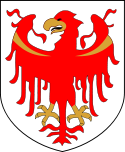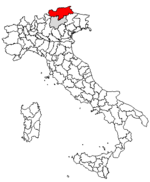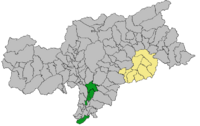Province of Bolzano-Bozen
 |
|
| Nation | |
| Region | Trentino-Alto Adige/Südtirol |
| Capital | Bolzano |
| Area | 7,399.97 km² |
| Population (2006) | 487,673 |
| Density | 65 |
| Comuni | 116 |
| Vehicle Registration | BZ |
| Postal Code | 39XXX |
| Telephone Prefix | 0471, 0472, 0473, 0474 |
| ISTAT | 021 |
| President | Luis Durnwalder |
 |
|
| Map highlighting the location of the province of Bolzano-Bozen in Italy | |
The Province of Bolzano-Bozen[1][2][3] (Italian: Provincia autonoma di Bolzano; German: Autonome Provinz Bozen; Ladin: Provinzia autonoma de Bulsan), also referred to in English as Alto Adige (from the Italian name) or South Tyrol (from the German name Südtirol) is an autonomous province of Italy.[4] In the Ladin language, both Adesc Aut[5][6] and Sudtirol are used.
The province of Bolzano-Bozen is one of the two provinces which make up Italy's region of Trentino-Alto Adige/Südtirol, which itself is an autonomous region. The province is divided into 116 comuni (municipalities)[7]. Its capital is the city of Bolzano (German: Bozen, Ladin: Balsan). The province has an area of 7,400 km² and a total population of 487,673 (2006). The region is renowned for its mountains, such as the Dolomites, which compose a significant section of the Alps.
Contents |
Toponyms
The name "Province of Bolzano-Bozen" used throughout this article is the naming convention adopted by other English-language sources such as Encyclopedia Britannica.[8][9]
The name listed in the 1972 Statute of Autonomy (constitutional law of the State) and in the subsequent state laws is Provincia di Bolzano or Provincia autonoma di Bolzano, accompanied by the official translation into German (Provinz Bozen or Autonome Provinz Bozen).
The provincial authorities often use the dual designation Provincia autonoma di Bolzano – Alto Adige or in German Autonome Provinz Bozen – Südtirol. The Ladin name is not listed in the Statute of Autonomy or other laws of the State, but is often translated by the provincial government as Provinzia autonòma de Balsan – Südtirol, with the German name appended. Typically in Ladin however, simply the term Provinzia autonoma de Bulsan is used (Bulsan is interchangeable with Balsan).[10] Ladin occasionally uses the two names independently, respectively Adesc Aut [11][12] and Sudtirol (without an umlaut).[13] The provincial website also offers the French translation of Province Autonome du Bozen – Tyrol du Sud, although typically the denominations Province autonome de Bolzano and Haut-Adige are used in this language (the French Haut-Adige was the first use of the term Alto Adige to describe a political entity). The provincial website also uses Province of Bozen – South Tyrol as an English translation, although within the English main page Province of Bolzano/Bozen is used.
In English, both Alto Adige and South Tyrol are regularly used. The provincial administration uses both terms on its website,[14][15] while the official tourist website consistently prefers the latter.[16] Both terms may be considered as culturally and politically charged, possibly because the term Alto Adige stresses the geographical location of the area within the Mediterranean drainage basin, while the term South Tyrol emphasizes the historical and cultural links with Austria's federal state of Tyrol. There are some German speakers who insist the term Sudtirolo should replace the term Alto Adige entirely (even though proper Italian would be Tirolo del Sud).[17] It is important to note that prior to 1919 "South" or "Southern" Tyrol would have simply referred to the southern portion of the county of Tyrol (south of the Alpine water divide down to the northern tip of Lake Garda), and today what encompasses most of the region Trentino-Alto Adige/Südtirol.
Government
The local government system is based upon the provisions of the Italian constitution and the Autonomy Statute of the Region Trentino-Alto Adige/Südtirol.[18] The extensive self-government provided by the current institutional framework has been advanced as a model for settling interethnic disputes.[19]
The residual legislative power of the province is vested in a provincial assembly called Consiglio della Provincia Autonoma di Bolzano in Italian, [20] Südtiroler Landtag in German [21] and Cunsëi dla Provinzia Autonoma de Bulsan in Ladin [22]. Official documents in English use the translation "Parliament of the Autonomous Province of Bolzano/Bozen". [23] The legislative powers of the provincial assembly cover all those subject matters that are not expressly reserved to the exclusive legislative power of the Italian State or to concurrent legislation per article 117 of the Italian Constitution.
The executive powers are attributed to a provincial government called Giunta Provinciale[24] in Italian and Landesregierung[25] in German.
The province is divided into eight districts (Italian: comprensorio, German: Bezirksgemeinschaft), one of them being the capital city of Bolzano. Each district is headed by a president and two bodies called the district committee and the district council. The districts are responsible for intermunicipal disputes, roads, schools and social services such as retirement homes.
The districts are:

- Bolzano
- Burggrafenamt
- Eisacktal
- Puster Valley
- Salten-Schlern
- Überetsch-Unterland
- Vinschgau Valley
- Wipptal
Language
| Languages of the province of Bolzano-Bozen (graphic shows the language which is a majority in each district) | |
|---|---|
 |
|
| Official language(s) | German Italian Ladin |
| Source | [1] |
Both Italian and German have the status of co-official languages in the province of Bolzano-Bozen. Ladin is the additional official language in some municipalities. According to the census of 2001, 5 communes out of a total of 116 have a majority of people who speak Italian as first language; 103 have a majority of German speakers and 8 of Ladin speakers.
The linguistic breakdown according to the census of 2001:[26]
| Language | Number | Percentage |
|---|---|---|
| German | 290,774 | 69.38 |
| Italian | 110,206 | 26.30 |
| Ladin | 18,124 | 4.32 |
| Total | 419,104 | 100 |
The Italian-speaking minority is mainly based around the city of Bolzano, where they are the majority (73% of the population). There are other four comuni where the Italian-speaking population is the majority are Laives, Salorno, Bronzolo and Vadena. Eight comuni are Ladin majority: La Valle, Badia, Corvara in Badia, Marebbe, San Martino in Badia, Santa Cristina Val Gardena, Selva di Val Gardena, Ortisei).
Geography

The Province of Bolzano-Bozen is located at the northernmost point in Italy. The province is bordered by Austria to the east and north and by Switzerland to the west. The Italian provinces of Belluno, Trento, and Sondrio border to the southeast, south, and southwest, respectively. The landscape itself is mostly cultivated with different types of shrubs and forests.
Climate
The climate is very similar to the Austrian Tyrol's climate. It may be divided in five distinct groups:
The Adige’s valley area, with cold winters (24-h averages in January of about 0°C) and hot summers (24-h averages in July of about 23°C), usually classified as Humid subtropical climate - Cfa. It’s the driest and sunniest climate of the province. Main cities in this area: Bolzano, Egna.
The midlands between 300 and 900 meters, with cold winters (24-h averages in January between minus 3°C and plus 1°C) and mild summers (24-h averages in July between 15°C and 21°C); This is a typical Oceanic climate, classified as Cfb. It’s usually wetter than the subtropical climate, and very snowy during the winters. During the spring and the fall, there is a large foggy season, but fog may occur even during the summer’s mornings. Main towns in this area: Merano, Bruneck, Sterzing, Brixen. Near the lakes in higher lands (between 1000 and 1400 meters) the humidity may make the climate in these regions milder during the winters, but also cooler during the summers, then, may occur a Subpolar oceanic climate, Cfc.
The alpine valleys between 900 and 1400 meters, with a typically Humid continental climate – Dfb, covering the largest part of the province. The winters are usually very cold (24-h averages in January between minus 8°C and minus 3°C), and the summers, mild with averages between 14 and 19°C. It’s a very snowy climate, snow may occur since early October until April or even May. Main municipalities in this area: Ortisei, Badia, Sexten, Toblach, Stilfs, Vöran, Mühlwald.
The alpine valleys between 1400 and 1700 meters, with a Subarctic climate – Dfc, with harsh winters (24-h averages in January between minus 9°C and minus 5°C) and cool, short, rainy and foggy summers (24-h averages in July of about 12°C). These areas usually have five months below the freezing point, and snow sometimes occur even during the summer, in September. This climate is the wettest of the province, with large rainfalls during the summer, heavy snowfalls during spring and fall. The winter is usually a little drier, marked by freezing and dry weeks, although not sufficiently dry to be classified as a Dwc climate. Main municipalities in this area: Corvara, Sëlva, Santa Crestina Gherdëina.
The highlands above 1700 meters, with an alpine Tundra climate, ET, which becomes an Eternal-Frost climate, EF above 3000 meters. The winters are cold, but sometimes not as cold as the higher valleys winters. In January, most of the areas at 2000 meters have an average temperature of about minus 5°C, while in the valleys at about 1600 meters, the mean temperature may be as low as minus 8 or minus 9°C. The higher lands, above 3000 meters are usually extremely cold, with averages of about minus 14°C during the coldest month, January.
Mountains

Entirely located in the Alps, the province's landscape is dominated by mountains. The highest peak is the Ortler (3,905 m) in the far west, which is also the highest peak in the Eastern Alps outside the Bernina range. More famous even are the craggy peaks of the Dolomites in the eastern part of the region.
The following mountain groups are (partially) in Bolzano-Bozen. All but the Sarntal Alps are on the border with Austria, Switzerland, or other Italian provinces. The ranges are clockwise from the west and for each the highest peak is given that is within the province or on its border.
| Name | Highest peak | metres | feet |
|---|---|---|---|
| Ortler Alps | Ortler | 3,905 | 12,811 |
| Sesvenna Range | Monpiccio / Muntpitschen | 3,162 | 10,374 |
| Ötztal Alps | Weißkugel | 3,746 | 12,291 |
| Stubai Alps | Wilder Freiger | 3,426 | 11,241 |
| Sarntal Alps | Punta Cervina / Hirzer | 2,781 | 9,124 |
| Zillertal Alps | Gran Pilastro / Hochfeiler | 3,510 | 11,515 |
| Hohe Tauern | Picco dei Tre Signori / Dreiherrnspitze | 3,499 | 11,480 |
| Eastern Dolomites | Punta dei Tre Scarperi / Dreischusterspitze | 3,152 | 10,341 |
| Western Dolomites | Marmolada | 3,343 | 10,968 |
| Lagorai | Cima d'Asta | 2,847 | 9,341 |
History
The Province of Bolzano-Bozen is an administrative entity the origins of which go back to World War I. Formerly part of the Austro-Hungarian county of Tyrol, it was annexed by Italy at the end of the war and incorporated into the region Venezia Tridentina. The province as it exists today was created in 1926 after an administrative reorganization of the Kingdom of Italy. An autonomous status was granted after World War II, resulting in a considerable level of self-government.[27]
Economy
Out of the 487,673 residents of the province, 223,300 are employed (2005). The majority of those are employed in a variety of sectors, which include: agriculture, small businesses, industry, commerce, tourism, and the service industry, or are self-employed. The unemployment level in 2005 was roughly 2.8%, which is lower than the national Italian average of 7% (2006), or the Austrian average of 4.9% (2006). Small businesses are primarily involved cabinet making, construction, painting and decorating, plumbing, meat preparation, and baking. The province also acts as a bridge between the northern European and Italian markets, and accounts for 8 percent of the money Italy earns from hotels and other lodging.
Sports
A German- and Ladin-speaking football team from the Province of Bolzano-Bozen played in the tournament for European minorities in Switzerland in 2008. The inaugural Europeada 2008 was won by this team (using the name South Tyrol) after beating the Croats in Serbia and the Roma team in the finals and semi-finals, respectively.
Friendship agreements
References
- ↑ "Italian Republic" (PDF). Encyclopedia Britannica. Retrieved on 2007-07-06.
- ↑ "Trentino-Alto Adige". Encyclopedia Britannica concise. Retrieved on 2007-07-06.
- ↑ "Popolazione residente al 1 Gennaio 2006 per età, sesso e stato civile Provincia: Bolzano-Bozen". Istat census data. Retrieved on 2007-11-30.
- ↑ "Autonomy Statute" (PDF). Official website of the Province. Retrieved on 2007-07-06.
- ↑ Noeles.net - informazion ladina - Referendum a souramont
- ↑ Associazione Culturale Nternet Padano
- ↑ "Province Statistics". Italian institute of statistics (Istat). Retrieved on 2007-07-06.
- ↑ "Italian Republic" (PDF). Encyclopedia Britannica. Retrieved on 2007-07-06.
- ↑ "Trentino-Alto Adige". Encyclopedia Britannica concise. Retrieved on 2007-07-06.
- ↑ "Cunsëi dla Provinzia Autonoma de Bulsan". Provincial Council Homepage. Retrieved on 2007-11-27.
- ↑ "Les unions ladines da souramont: enviede via l referendum!". Retrieved on 2007-11-15.
- ↑ "Les raijes retiches di Ladins". Retrieved on 2007-11-15.
- ↑ "Les unions ladines da souramont: enviede via l referendum!". Retrieved on 2007-11-15.
- ↑ "Special Statute for Trentino-Alto Adige" (PDF). Official homepage of the province. Retrieved on 2007-11-14.
- ↑ "Welcome to South Tyrol". Official homepage of the province. Retrieved on 2007-11-14.
- ↑ "The official entry page for South Tyrol". Official touristic website. Retrieved on 2007-11-15.
- ↑ "Union präsentiert Toponomastikgesetzentwurf". Retrieved on 2007-11-28.
- ↑ "Special Statute for Trentino-Alto Adige" (PDF). Retrieved on 2007-11-14.
- ↑ "Tbilisi’s S.Ossetia Diplomatic Offensive Gains Momentum". Retrieved on 2007-11-14.
- ↑ "Official homepage in Italian". Retrieved on 2007-11-14.
- ↑ "Official homepage in German". Retrieved on 2007-11-14.
- ↑ "Official homepage in Ladin". Retrieved on 2007-11-14.
- ↑ "Special Statute for Trentino-Alto Adige/Südtirol (page 2 of 55)" (PDF). Retrieved on 2007-11-15.
- ↑ "Official homepage in Italian". Retrieved on 2007-11-14.
- ↑ "Official homepage in German". Retrieved on 2007-11-14.
- ↑ "South Tyrol in figures" (PDF). Table 9 - Declarations of which language group belong to/affiliated to - Population Census 2001. Retrieved on 2007-11-15.
- ↑ Anthony Alcock. "The South Tyrol Autonomy. A Short Introduction" (PDF). Retrieved on 2007-11-14.
- ↑ "Cina: Inaugurato Centro Sci Dolomiti Made In Alto Adige". Retrieved on 2007-11-27.
See also
- Valleys of the province of Bolzano-Bozen
- Communes of the province of Bolzano-Bozen
- List of castles in the province of Bolzano-Bozen
External links
- Official homepage of the provincial administration
- Special Statute for Trentino-Alto Adige
- Official touristic website
|
|||||
|
|||||||||
